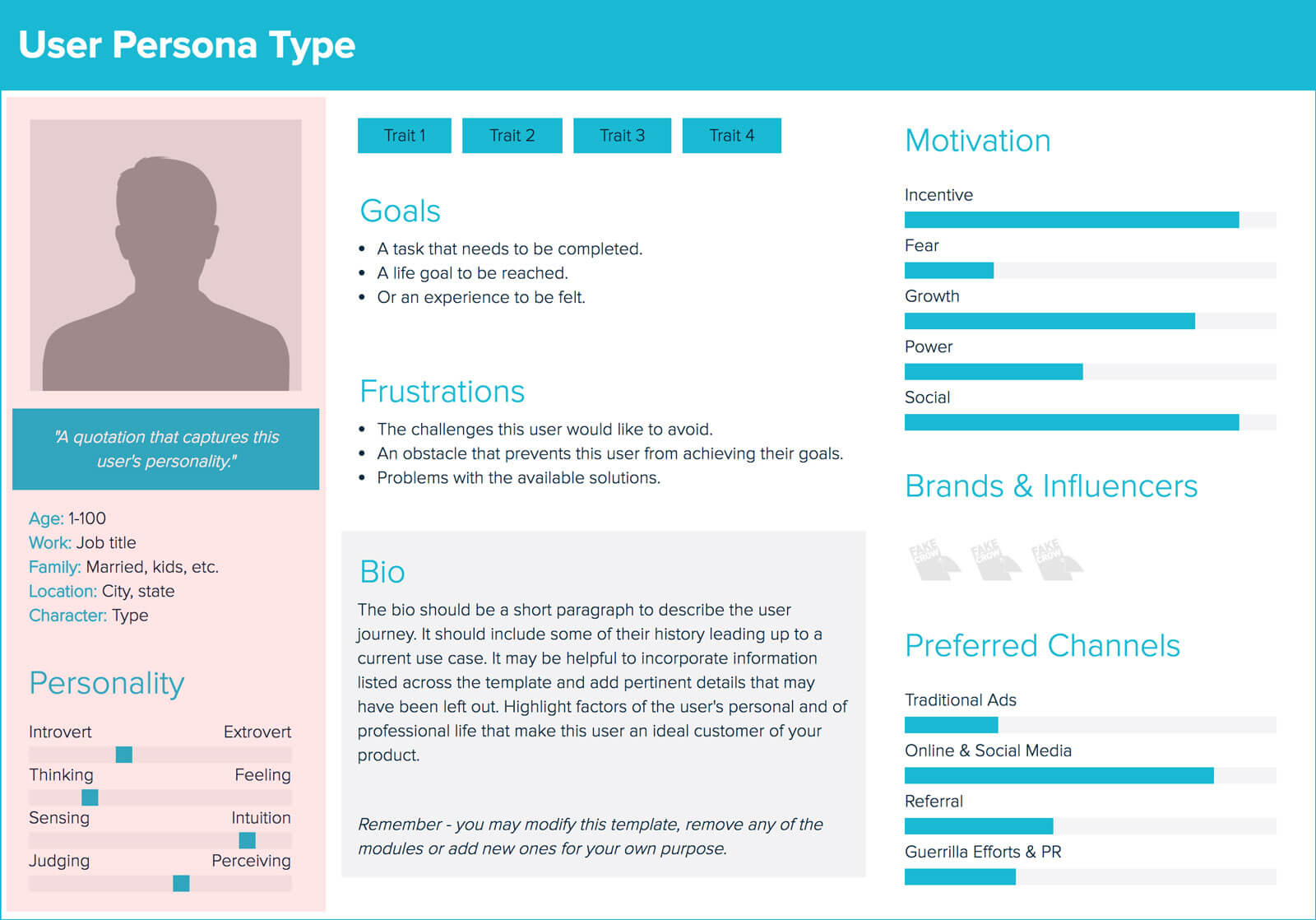
User Personas: What They Are and Why They’re Important
Defining User Personas
What is a user persona? What does it include?
User personas are archetypes that reflect the goals, needs, and traits of a larger set of users. They generally take the form of a 1-page document with the following information:
- Name and mini bio
- Demographics: Age, gender, location, educational background, professional background
- Needs, goals, and frustrations
- Other contextual details (hobbies, favorite brands, etc.)

The majority of information in a persona should be based on research into a company’s users, but there are often a few small fictional details that are included to round out the archetype.
It’s also helpful to include information that is specific to the product or industry in question: For example, a user persona for a JavaScript charting library could include programming languages that the user is familiar with, their level of technical expertise, or their preferred dataviz tools.
Additionally, it’s common to see a quote from the user, which could be a direct quote from an interview or survey, or a blend of multiple quotes.
Some companies find a single user persona to be sufficient, while others may require multiple personas, depending on whether their target audience can be segmented into distinct groups.
Creating User Personas
At what stage in our research process do we create personas? What information needs to be gathered before we can create them?
UX designers and marketers often work together in the creation of user personas. They are usually created at the end of the research phase, after conducting primary and secondary research into a company’s target audience and collecting as much data as possible. However, like any design or marketing deliverable, user personas can (and should) be iterative; they should be updated if the team uncovers any new and significant information about their users as they move through the design and development process.
The more research data that goes into a persona, the more accurate (and therefore valuable) the persona will be.
If time and budget allow for it, primary research is ideal (i.e., field research where new data is gathered), whether in the form of 1-on-1 interviews, focus groups, surveys, contextual inquiries, etc.
Secondary research (i.e., desk research gathering existing data from other sources) can be used to round out any gaps or ambiguities from the primary research. This can take the form of website analytics, logs from CRM tools, and general research into the industry or top competitors.
If a persona is created using only secondary research, it is referred to as a “provisional persona”, and serves as a useful placeholder until something more accurate is created.
Whatever research methods are used, it’s important to collect as much information as possible: Demographics, psychographics, needs, goals, frustrations, and any other data relevant to the product or company at hand.
It’s also essential to keep in mind how many user personas you’ll be creating, so you can make sure you’re gathering this data for every group that needs to be represented. If the stakeholders for the project already know a lot about their target audiences, the number of personas needed may be well established upfront. Other times, research may uncover how many personas are necessary (there is no steadfast rule, but generally speaking, 3-8 is often sufficient).

Importance of User Personas
Why do we create user personas? What value do they provide?
User personas synthesize all the data designers and marketers have collected into something that can be referenced quickly and easily by the entire team. Their format makes them easily digestible for everyone, so that research findings can be communicated efficiently.
Without artifacts like user personas, it’s easy for all the research conducted at the beginning of a project to become scattered and buried in people’s personal computers, folders, and notebooks, which defeats its original purpose: to inform the team’s decisions along the way and ensure that what they’re building actually meets the needs of their target audience.
A user persona that isn’t grounded in real data but instead based off assumptions and stereotypes is ineffective at best, and detrimental to business goals at worst.
The more deeply you understand and empathize with your users, the more likely you are to create a product or experience that aligns with their needs. While there are best practices and heuristics that impact usability for the generic user, it’s valuable for designers to work with a specific user (or set of users) in mind.
User personas help us keep the goals, frustrations, and motivations of our target audience top of mind throughout the entire design and development process—shifting the question from “What are we selling to our users?” to “What problem(s) are we solving for our users?”. They serve as an important guide as the team makes key decisions and works together to craft the customer experience.
Personas can also prevent and settle disagreements around design decisions by serving as a single source of truth, and avoiding the phenomenon of “elastic users”. Without a shared understanding of the target audience, different people on the team may have various interpretations of the goals, needs, and motivations of their user base. In this situation, the “user” becomes a generic placeholder that any stakeholder can define how they want (i.e., “elastic”), which makes it difficult to determine the best design solutions.
Using User Personas
After creating user personas, how do we use them going forward? How do we avoid potential pitfalls or challenges in their creation and implementation?
The primary way that we use personas is to create user scenarios, which describe how a persona interacts with a product in a specific context to achieve certain end goals. Scenarios help inform requirements, which in turn help us iterate on user flows and solutions.

User personas also help the team to prioritize features. This is not to say that they should be the only mechanism for driving prioritization, as business goals are a key part of this process as well. But personas are crucial for determining how well a particular feature lines up with the needs and expectations of the target audience. It wouldn’t make sense to spend a ton of time and resources building out pieces of a product or website that don’t provide much value to users.
Communicating the value of user personas to stakeholders is critical. It can be hard for people to see their merit, especially if they feel they already know a lot about their customers. But as mentioned earlier, a key benefit of user personas is that they help keep everyone aligned with a shared understanding of their users. There may be a lot of collective knowledge within a team or company, but without a clear picture where everyone can find common ground, decisions will be slowed down by disagreements and conflicting assumptions.
The best way to get buy-in on the importance of user personas is to actively involve key stakeholders in their creation and usage. UX designers and marketers shouldn’t be the only ones who feel a sense of ownership—Everyone should feel invested in user personas and understand the effort it takes to create them.
Show the team the research activities needed to create the persona, and involve them when possible. Instead of treating user personas like a static digital artifact, print them out and create posters or other physical adaptations that people can reference at any time. Bring them to meetings and use them to frame discussions with coworkers. Demonstrate how they can be used to create user scenarios, outline usability testing tasks, develop segments for analytics tools, and any other ways you can illustrate their necessity in projects.
The more people on your team that feel empowered to make decisions with user personas, the less likely it will be that the personas are left forgotten and unused. A good measure of success is when you regularly hear coworkers referencing the names of the personas as if they were actual people. As a vital component of user-centered design, user personas should undoubtedly play an integral role on your team.
If you want to empower your team and give them user personas to help drive decisions, get in touch with the form below or head over to our contact page.